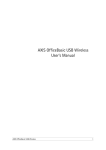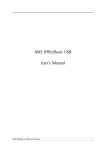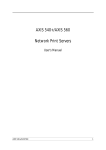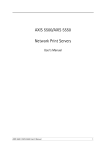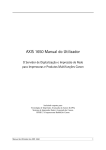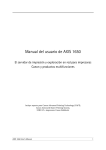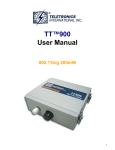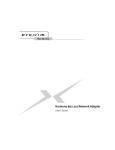Download Axis USB Wireless G User`s manual
Transcript
AXIS OfficeBasic USB Wireless G User’s Manual AXIS OfficeBasic USB Wireless G 1 Regulatory Information Safety Notices - Take some time to read through the safety notices before installing the AXIS OfficeBasic USB Wireless G. Please observe all safety markings and instructions when using this product. Important!: - must be observed to avoid operational impairment. Do not proceed any of the above notices, until you have fully understood the implications. Radio Transmission Regulatory information - Tested to comply with FCC Standards FOR HOME OR OFFICE USE. This product must be installed and used in strict accordance with the instructions given in the user documentation. The AXIS OfficeBasic USB Wireless G complies with the following radio frequency and safety standards: Europe - This digital equipment fulfils the requirements for radiated emission according to limit B of EN55022, and the requirements for immunity according to EN55024 residential, commercial, and light industry. Technical requirements for radio equipment according to EN 300 328-1 (2001-12) and 300 328-2 (2001-12) USA - Federal Communications Commission FCC. This device complies with Part 15 of FCC Rules. Operation of the device is subject to the following two conditions: (1) This device may not cause harmful interference (2) This device must accept any interference that may cause undesired operation. Important! - The channel must be set according to the radio frequency requirements in your country: Japan - This is a class B product based on the standard of the Voluntary Control Council for Interference from Information Technology Equipment (VCCI). If this is used near a radio or television receiver in a domestic environment, it may cause radio interference. Install and use the equipment according to the instruction manual. Liability - Every care has been taken in the preparation of this manual; if you detect any inaccuracies or omissions, please inform your local Axis office, which can be found on the cover of this document. Axis Communications AB cannot be held responsible for any technical or typographical errors and reserves the right to make changes to the product and manuals without prior notice. Axis Communications AB makes no warranty of any kind with regard to the material contained within this document, including, but not limited to, the implied warranties of merchantability and fitness for a particular purpose. Axis Communications AB shall not be liable nor responsible for incidental or consequential damages in connection with the furnishing, performance or use of this material. Safety: EN60950 Trademark Acknowledgments - Apple, Ethernet, Hewlett Packard, Mac OS, Microsoft Windows, are registered trademarks of the respective holders. Software Acknowledgments - This product includes software developed by the OpenSSL Project for use in the OpenSSL Toolkit. Support Services - Should you require technical assistance, please contact your Axis dealer. If your questions cannot be answered immediately, your Axis dealer will forward your queries through the appropriate channels to ensure you a rapid response. If you are connected to the Internet, you can find online manuals, technical support, software updates, application software, corporate information, etc. at http://www.axis.com/techsup USERS MANUAL AXIS OBWG Part No: 23687 rev. 1.0 Date: April 2005 Copyright © Axis Communications AB, 2005 2 AXIS OfficeBasic USB Wireless G Table of Contents Product Overview . . . . . . . . . . . . . . . . . . . . . . . . . . . . . . . . . . . . . . . . . . . . . . . . . . . . . . . . . . 5 Hardware Inventory . . . . . . . . . . . . . . . . . . . . . . . . . . . . . . . . . . . . . . . . . . . . . . . . 5 Print Server Management . . . . . . . . . . . . . . . . . . . . . . . . . . . . . . . . . . . . . . . . . . . 5 Wireless Operating Modes . . . . . . . . . . . . . . . . . . . . . . . . . . . . . . . . . . . . . . . . . . . 5 Infrastructure (Access Point) . . . . . . . . . . . . . . . . . . . . . . . . . . . . . . . . . . . . . 6 Ad Hoc (Peer to Peer) . . . . . . . . . . . . . . . . . . . . . . . . . . . . . . . . . . . . . . . . . . 6 Wireless Frequency Bands and Channels . . . . . . . . . . . . . . . . . . . . . . . . . . . . . . . 7 Windows Printing Methods . . . . . . . . . . . . . . . . . . . . . . . . . . . . . . . . . . . . . . . . . . . . . . . . . . . 9 Standard TCP/IP - Raw TCP Method in Windows 2000/XP/2003 . . . . . . . . . . . . 9 Using the Microsoft LPR Monitor in Windows 2000/XP . . . . . . . . . . . . . . . . . . 12 IPP (Internet Printing Protocol) Configuration . . . . . . . . . . . . . . . . . . . . . . . . . . 13 Mac OS Setup . . . . . . . . . . . . . . . . . . . . . . . . . . . . . . . . . . . . . . . . . . . . . . . . . . . . . . . . . . . . 17 IP Printing in Mac OS X . . . . . . . . . . . . . . . . . . . . . . . . . . . . . . . . . . . . . . . . . . . . 17 Installation on Mac OS 9.1 or older, using AppleTalk . . . . . . . . . . . . . . . . . . . . 17 Choosing a Printer . . . . . . . . . . . . . . . . . . . . . . . . . . . . . . . . . . . . . . . . . . . . 18 Print Server Management . . . . . . . . . . . . . . . . . . . . . . . . . . . . . . . . . . . . . . . . . . . . . . . . . . . 19 Print Server Management from a Web Browser. . . . . . . . . . . . . . . . . . . . . . . . . 19 Status . . . . . . . . . . . . . . . . . . . . . . . . . . . . . . . . . . . . . . . . . . . . . . . . . . . . . . Setup . . . . . . . . . . . . . . . . . . . . . . . . . . . . . . . . . . . . . . . . . . . . . . . . . . . . . . . Maintenance . . . . . . . . . . . . . . . . . . . . . . . . . . . . . . . . . . . . . . . . . . . . . . . . Restart . . . . . . . . . . . . . . . . . . . . . . . . . . . . . . . . . . . . . . . . . . . . . . . . . . . . . 20 22 27 27 Print server management using the Reset button . . . . . . . . . . . . . . . . . . . . . . . 28 Reset the Print Server: . . . . . . . . . . . . . . . . . . . . . . . . . . . . . . . . . . . . . . . . . 28 Print a Test Page . . . . . . . . . . . . . . . . . . . . . . . . . . . . . . . . . . . . . . . . . . . . . 28 Perform a Factory Default: . . . . . . . . . . . . . . . . . . . . . . . . . . . . . . . . . . . . . 29 Upgrading the Print Server’s Firmware . . . . . . . . . . . . . . . . . . . . . . . . . . . . . . . . . . . . . . . . . 31 Upgrading the Firmware . . . . . . . . . . . . . . . . . . . . . . . . . . . . . . . . . . . . . . . 31 Appendix 1: Set a Temporary IP Address with Arp/Ping . . . . . . . . . . . . . . . . . . . . . . . . . . . . . 33 AXIS OfficeBasic USB Wireless G 3 Appendix 2: Enabling WEP/WPA in the AXIS OfficeBasic USB Wireless G . . . . . . . . . . . . . . . 35 Appendix 3: Troubleshooting . . . . . . . . . . . . . . . . . . . . . . . . . . . . . . . . . . . . . . . . . . . . . . . . . 36 Frequently Asked Questions . . . . . . . . . . . . . . . . . . . . . . . . . . . . . . . . . . . . 38 Technical Specifications . . . . . . . . . . . . . . . . . . . . . . . . . . . . . . . . . . . . . . . . . . . . . . . . . . . . 39 Index . . . . . . . . . . . . . . . . . . . . . . . . . . . . . . . . . . . . . . . . . . . . . . . . . . . . . . . . . . . . . . . . . . . 41 4 AXIS OfficeBasic USB Wireless G Product Overview Product Overview This User’s Manual provides detailed information on using the AXIS OfficeBasic USB Wireless G print server (with firmware version 9.02.32x or higher) in Microsoft Windows (2000, XP, Server 2003) and Mac OS (TCP/IP and AppleTalk) environments. Instructions on how to install the AXIS OfficeBasic USB Wireless G are described in the Installation Guide. Hardware Inventory Unpack and check all the items using the following check list. Contact your dealer if anything is missing or damaged. All packing materials are recyclable. Print Server AXIS OfficeBasic USB Wireless G Media Model PROD UNIT AXIS OB USB W <EUR> ch 1-13 PROD UNIT AXIS OB USB W <US> ch 1-11 PROD UNIT AXIS OB USB W <JP> ch 1-14 Title Part Number 0208-001-01 0208-004-01 0208-005-01 Part Number CD AXIS OfficeBasic USB Wireless G CD Rev 1.0 or higher Printed Material AXIS OfficeBasic USB Wireless G User’s Guide Rev. 1.0 or higher Accessories Cable Power Adapter PS-N Description USB Model Europe UK USA/Japan Australia Part Number 24238 Part Number 23514 23515 23516 23517 Print Server Management The embedded web server provides access to configuration and management pages for the print server and the connected printer, see Print Server Management from a Web Browser, on page 19. Alternatively, the print server can be configured from the provided Windowsbased software OBW Setup Wizard, see Windows Setup, on page 13. Wireless Operating Modes The AXIS OfficeBasic USB Wireless G print server can be used in Infrastructure and Ad-Hoc network modes using 802.11b and 802.11g wireless standards. AXIS OfficeBasic USB Wireless G 5 Product Overview Infrastructure (Access Point) In Infrastructure mode, computers communicate with the print server by first going through an Access Point. The Access Point is a hardware device that communicates with the print server and can be connected to computers on a wired Local Area Network (LAN) or, wirelessly, to computers that are equipped with a wireless card. Infrastructure mode is most commonly used, both for printing and configuration purposes. See Windows Setup, on page 13 or Mac OS Setup, on page 17 for installation instructions. Ad Hoc (Peer to Peer) Workstations and laptop computers communicate directly over the WLAN with the print server. Ad Hoc is used for configuration and printing purposes. If you lose contact with the print server, you can try reaching it using Ad Hoc mode, see Installation Guide. 6 AXIS OfficeBasic USB Wireless G Product Overview Wireless Frequency Bands and Channels When setting up a wireless network, it is important that the radio frequency channel setting is the same on all communicating clients and that the channel is set according to the requirements in your country. Frequency bands and channels: Country Frequency Available Channels Default Channel Europe 2.412-2.472 GHz 1-13 11 France 2.457-2.472 GHz 10-13 (indoor use*) 11 Japan 2.484 GHz 14 14 US/Canada 2.412-2.462 GHz 1-11 11 * (France) outdoor use permitted on private property with prior authorization AXIS OfficeBasic USB Wireless G 7 Product Overview 8 AXIS OfficeBasic USB Wireless G Windows Printing Methods Windows Printing Methods This chapter describes three alternative methods for printing when using the Infrastructure mode. These may be used if printing problems are experienced after installing the AXIS OfficeBasic USB Wireless G. Standard TCP/IP - Raw TCP Method in Windows 2000/XP/2003 To add a network printer to your printer list in Windows 2000/XP/2003 using Standard TCP/IP - Raw TCP: 1. Make sure your print server has a valid IP address, see Setting the Print Server’s IP Address, on page 10. 2. Windows XP/Server 2003: Go to Start | (Settings) | Printers and Faxes and click the Add a Printer icon to start the Add Printer Wizard. Click Next. Windows 2000: Go to Start | Settings | Printers and click the Add Printer icon to start the Add Printer Wizard. Click Next. 3. Select Local Printer attached to this computer and make sure the Automatically detect and install my Plug and Play printer check box is not checked. Click Next. 4. Click the Create a new port radio button and select Standard TCP/IP Port from the list. Click Next and the Add Standard TCP/IP Printer Port Wizard starts. Click Next. AXIS OfficeBasic USB Wireless G 9 Windows Printing Methods 5. In the Printer Name or IP Address field, enter the IP address of the AXIS OfficeBasic USB Wireless G (Example: 192.168.3.191) The Port Name field will be filled in automatically. Click Next. 6. Go to step 7 if using Windows XP SP2 or later. Otherwise, select Device Port: LPT1 and click Next. 7. Select Manufacturer and Printer from the lists. Click Next and Finish. 8. If you already have the printer’s driver installed, you will be asked whether to keep it or to replace it. Click Next. Supply a name for the printer and choose whether you want to make it your default printer. Click Next. 10 AXIS OfficeBasic USB Wireless G Windows Printing Methods 9. Choose whether you want to share the printer with other network users, print a test page, etc. Select the appropriate radio button and click Next and Finish. 10. Next, from Printers (and Faxes), highlight the installed printer and rightclick, choose Properties, then Ports | Configure Port. AXIS OfficeBasic USB Wireless G 11 Windows Printing Methods 11. Change Protocol from LPR to Raw. Port number 9100 is automatically selected. Click OK. 12. Print a test page to verify the installation. Using the Microsoft LPR Monitor in Windows 2000/XP This section describes how to set up a Windows 2000/XP server for LPR printing, using the built-in Microsoft LPR Monitor, Print Services for UNIX. Basic Setup Preparing for LPR Printing If you have not already done so, you should perform the TCP/IP basic setup procedures prior to installing a printer for LPR printing. Follow the following steps to prepare for LPR printing: 1. Open the Control Panel. 2. Click Add/Remove Programs. 3. Click Add/Remove Windows Components. 4. Check Other Network File and Print Services and click Details. 5. Check Print Services for Unix and click OK. 6. Click Next and Finish. 7. Close Add/Remove Programs and the Control Panel. 12 AXIS OfficeBasic USB Wireless G Windows Printing Methods Installing an LPR printer Windows 2000/XP/Server 2003: Follow the instructions below to use the standard Windows method for installing an LPR printer in Windows 2000/XP/Server 2003: 1. Make sure your print server has a valid IP address, see Setting the Print Server’s IP Address, on page 10. 2. Windows XP/Server 2003: Go to Start | (Settings) | Printers and Faxes and click the Add a Printer icon to start the Add Printer Wizard. Click Next. Windows 2000: Go to Start | Settings | Printers and click the Add Printer icon to start the Add Printer Wizard. Click Next. 3. Select Local Printer. Click Next. 4. Click the Create a new port radio button and select LPR Port from the list. Click Next. 5. Type the name of your AXIS OfficeBasic USB Wireless G or IP address (Example: 192.168.3.191) in the Name or address of server providing LPD field and enter the port you want to use in the Name of printer or print queue on that server filed (Example: usb or lp1). Click OK. 6. End the wizard in the usual manner, select Manufacturer and Printer, keep/replace driver, name the printer, make it default or not, share it or not and finally decide whether you want to print a test page. Important! • • Make sure that the Automatically detect and install my Plug and Play printer checkbox is not checked Press F1 to access the Windows online help system if you need additional help when installing a printer/print server using this method. IPP (Internet Printing Protocol) Configuration With IPP, you can send a document to any Internet-connected printer. IPP is platform-independent and can be used to print over any LAN or WAN that supports TCP/IP. In order to print to a remote printer using IPP, you need the following: • • An IPP client installed on your computer together with appropriate printer drivers. The IPP client is a tool that adds destination printers to your printer list. A list of available IPP clients can be viewed in IPP clients, on page 14. The printer to which you want to send your print job needs to be connected to a print server with IPP functionality. Axis print servers make it possible for a printer to receive print jobs from an IPP client. The IPP-functionality of the print server is automatically activated upon installation. AXIS OfficeBasic USB Wireless G 13 Windows Printing Methods IPP Printing Requirements Before you print to an IPP printer you need to know: • • • the print server’s IP-address or host name the local printer port name, which for AXIS OfficeBasic USB Wireless G is lp1. the brand and model of the printer in order to install the appropriate printer driver. Address-scheme for IPP printers The AXIS OfficeBasic USB Wireless G supports the IPP 1.0 standard (which uses the http: address scheme) and the IPP 1.1 standard (which uses the ipp:// standard). Example using host name in the 1.0 standard: If “192.168.3.191” is the IP address of the print server, "631" is the port number and "lp1" is the local printer port name, then the syntax of the address scheme will be http://192.168.3.191:631/lp1. Example using host name in the 1.1 standard: If “192.168.3.191” is the IP address of the print server and "lp1" is the local printer port name, then the syntax of the address scheme will be ipp://192.168.3.191/lp1. IPP clients An IPP client needs to be installed on your computer together with an appropriate printer driver for proper IPP functionality. An IPP client is a tool that adds destination printers to your printer list. Examples of available IPP clients For Windows 2000/XP/2003: the Microsoft IPP Client (automatically installed with OS). Microsoft Windows IPP client does not support IPP 1.1! • • Firewall Considerations IPP Printing from Windows For Windows 2000: the Internet Printer Connection software from Hewlett Packard (can be downloaded from the Hewlett Packard web site). If there are one or more firewalls between the IPP Client and the server, you may have to make some changes to the firewall configuration. IPP uses TCP Port 631 for printing, so any firewalls between client and server must be configured to allow bi-directional traffic on that port. In this example the print server’s IP address is 192.168.3.191. Thus, the IPP printer’s syntax is http://192.168.3.191:631/lp1. 1. Windows XP/Server 2003: Go to Start | (Settings) | Printers and Faxes and click the Add a Printer icon to start the Add Printer Wizard. Click Next. Windows 2000: Go to Start | Settings | Printers and click the Add Printer icon to start the Add Printer Wizard. Click Next. 2. The Wizard will ask you if you want to install a local printer or a network printer. Choose Network Printer and click Next. 14 AXIS OfficeBasic USB Wireless G Windows Printing Methods 3. Enter the printer address in the URL field, e.g. http://192.168.3.191:631/lp1 and click Next: 4. If you do not have a driver corresponding to the destination printer installed on your computer, the Wizard will prompt you to install one. Click OK. The Installation Wizard will ask you to select a printer driver corresponding to the destination printer. Select the printer driver from the list and click OK. 5. The Wizard will ask you if you want the printer to be your default destination printer. Make your choice and click Next to complete the Add Printer Wizard installation. 6. The new printer is added to your Select Printer window. Print a test page to verify the installation. AXIS OfficeBasic USB Wireless G 15 Windows Printing Methods 16 AXIS OfficeBasic USB Wireless G Mac OS Setup Mac OS Setup This chapter contains instructions for the following setup procedures: IP Printing in Mac OS X, on page 17 Installation on Mac OS 9.1 or older, using AppleTalk, on page 17 IP Printing in Mac OS X 1. Make sure the print server has obtained a valid IP address, see page 10. 2. Make sure the USB cable is properly connected to the printer. 3. From the Apple menu, select Go | Applications | Utilities and start the Print Center. 4. Click Add in the Printer List. 5. Select IP Printing from the top drop-down menu. 6. In the Printer’s Address field, enter the print server’s IP address or DNS name. 7. Either accept using the default user queue on the server by making sure the Use default queue on server check box is checked, or enter lp1 in the Queue name field: 8. From the Printer Model drop-down list, select the printer manufacturer and model. Click Add. 9. Your newly added printer will appear in the Printer List as the default printer (bold). Test the installation by sending a print job to the printer. Installation on Mac OS 9.1 or older, using AppleTalk Basic Configuration On Mac OS 9.1 or older, basic configuration in AppleTalk is performed simply by opening the Chooser window and selecting a printer. AXIS OfficeBasic USB Wireless G 17 Mac OS Setup Choosing a Printer Selecting a Printer The method for choosing a printer varies depending on which version of LaserWriter printer driver you are using. • • LaserWriter 7.0 Printer Driver The LaserWriter 7.0 driver assumes that you use a standard PostScript driver, and cannot take advantage of any printer specific features. The LaserWriter 8.0 driver uses PPD files that contain printer descriptions. This gives you full control over any features your printer might have. Follow the instructions below to choose a printer: 1. Select Chooser from the Apple menu. 2. Click the LaserWriter icon. 3. If your network has more than one zone, click on the zone you want. (If your network does not have any zones, this box will not appear.) 4. Click the name of the printer you want — the ports are shown as <host name>_<port>. Example: AX100086_USB. 5. Click the Close box. This completes the configuration and closes the Chooser. Repeat this procedure for each Macintosh computer on the network using the print server. LaserWriter 8.0 Printer Driver Follow the instructions below to choose a printer: 1. Select Chooser from the Apple menu. 2. Click the LaserWriter 8.0 icon. 3. If your network has more than one zone click on the zone you want. (If your network does not have any zones, this box will not appear.) 4. Click the name of the printer you want — the ports are shown as <host name>_<port>. Example: AX100086_USB. 5. Click Setup... , select the PPD file that matches your printer and click OK. If your printer does not appear in the PPD file list, please contact your printer vendor. Use the Generic PPD if you do not need any printer specific features. 6. Click OK, and then click the Close box. This completes the configuration and closes the Chooser. Repeat this procedure for each Macintosh computer on the network using the print server. 18 AXIS OfficeBasic USB Wireless G Print Server Management Print Server Management There are several tools and options to manage and edit print server settings: • Print Server Management from a Web Browser, on page 19 • Print server management using the Reset button, on page 28 Alternatively, the provided Windows-based software AXIS OBW Wizard, can be used for basic print server configuration. See Windows Setup, on page 13. Print Server Management from a Web Browser All Axis print servers contain an embedded web server that can be accessed through a web browser. The embedded web server provides access to configuration and management pages for the print server and the connected printer. Before you can use the embedded web server, the print server must be configured with an IP address, See Setting the Print Server’s IP Address, on page 10. 1. Enter the print server’s IP address in the Location/Address field of your Web browser. Press Enter. 2. The Wireless Print Server page will appear. From here you can configure all print server settings. Notes: • A quick way of finding the print server’s IP address is to press the reset button for 5 seconds to print a test page. The DHCP or static IP address is printed on the test page, however, not all printers support printing test pages. • The print server’s web interface will appear in the same language as your browser uses, see Technical Specifications, on page 39 for supported languages. AXIS OfficeBasic USB Wireless G 19 Print Server Management Status The Status menu displays the status of the System, Printer, Print Jobs, Wireless settings, TCP/IP, AppleTalk and SNMP. The entries in the Status menu are for viewing only, they are edited from the Setup menu, explained on page 22. System Status Print Server Name: Displays the name of the print server. If nothing is modified, the default name is AXISXXXXXX, where X represent the last six digits of the print server’s serial number. The serial number can be found on the label on the underside of the print server. System Contact: Displays the name of the contact person in charge of the print server. System Location: Displays the name of the print server’s physical location. Example: “Room A, color printer” System UpTime: Displays the uptime of the print server. When the print server is powered on, it will start counting. Firmware Version: Displays the print server’s firmware version. See Upgrading the Print Server’s Firmware, on page 31 for more information on firmware. Wireless MAC Address: Displays the Mac Address (Node ID) of the print server. All print servers have a unique Mac Address, and the serial number for the print server is based on the Mac Address. See Print Server’s Serial Number, on page 9 for more information. Wireless Operation Mode: Displays the current wireless operation mode of the print server. Printer Status Manufacturer: Displays the manufacturer of the connected printer. Model: Displays the model of the connected printer. Supported Printing Language: Displays the printer languages supported by the connected printer. Current Status: Displays the connected printer’s status. Printer Usage: Displays information about Job Count and Printed Pages. Print Job Status 20 Displays the current print jobs, including information on the Job, User, Elapsed Time, Protocol, Port, Status and Bytes Printed. AXIS OfficeBasic USB Wireless G Print Server Management Wireless Status Mode: Displays the wireless operation mode of your print server. AP’s MAC Address: Displays the MAC address of your wireless Access Point. SSID: Displays the SSID of your wireless network. Channel Number: Displays the current channel number. Data Transmit Rate: Displays the current transmit rate: Auto or 1 - 54Mbps. Transmit Mode: Displays the data transmission mode: b Only, g Only or Auto. Signal Strength: Displays the strength of the Access Point signal. Signal Quality: Displays the quality of the Access Point signal. Authentication Type: Displays the authentication used: Open System, Shared Key, WPA-PSK, WPA2-PSK. Encryption: Displays the encryption used: None, WEP-64, WEP-128, WPAPSK(TKIP), WPA-PSK(CCMP), WPA2-PSK(TKIP), WPA2-PSK(CCMP). TCP/IP Status Use DHCP/BOOTP: Displays DHCP/ BOOTP status. If there is a DHCP/BOOTP server on your network, the print server can obtain IP settings automatically, provided that this parameter is On. IP Address: Displays the IP address of the print server. The IP address must meet the IP addressing requirements of the network segment. Subnet Mask: Displays the subnet mask of the print server. The subnet mask must meet the IP addressing requirements of the network segment. Default router: Displays the default router used by the print server. Rendezvous Settings: Displays if Rendezvous is enabled or disabled. Service Name: Displays the print server’s Rendezvous service name. AppleTalk Status AppleTalk: Displays if Appletalk is enabled or disabled. AppleTalk Zone: If no zone exists, the zone name is displayed as an asterisk (*). Port Name: AXxxxxxx_USB, where xxxxxx represent the last six digits of the print server’s serial number, found on the print server’s label. Type: Displays the printer type connected to the print server. Binary protocol: • • • SNMP Status TBCP enables the print server to use the TBCP (Tagged Binary Communication Protocol) to transfer print data to the printer. BCP enables the print server to use the BCP (Binary Communications Protocol) to transfer print data to the printer. ASCII disables all binary transfers, select this alternative for all nonPostScript printers and for ASCII PostScript printing. SNMP Communities: Displays SNMP communities from the print server. There are two communities (SNMP Community 1, 2) that control messages from the AXIS OfficeBasic USB Wireless G 21 Print Server Management network management of the print server. SNMP Trap Settings: Displays SNMP traps sent from the print server. Send SNMP Traps: Displays if the print server’s ability to send SNMP Traps is Enabled or Disabled. Use Authentication Traps: If Enabled, an authentication failure trap is sent to the trap destination address if you have entered the wrong trap community. Trap Address 1: Displays the first IP address to which SNMP traps are sent. It corresponds to the trapAddress SNMP object. Trap Address 2: Displays the second IP address to which SNMP traps are sent. It corresponds to the trapAddress SNMP object. Setup All print server parameters are configured from the Setup menu. From here the Network Administrator can edit settings that govern System, Printer, TCP/IP, SNMP, AppleTalk, etc. All print server settings have default values that have been carefully selected by Axis. In most instances, there is no need to change these default values. System Print Server Name: Enter a name for the print server if you wish. If nothing is specified, the default print server name is AXISXXXXXX, where X represent the last 6 digits of the print server’s serial number. The serial number can be found on the label on the underside of the print server System Contact: Enter the name of the contact person in charge of the print server if you wish. System Location: Enter a descriptive name for the physical location of the print server if you wish. Example: “Room A, color printer”. Password: Enter an access password for the print server’s web pages if you wish. The default password is pass. The default user name is root. Wireless Setup Basic Settings Mode: Select the wireless setting mode you wish to use in your network. • • Infrastructure (Workstations and laptops communicate over the WLAN and the LAN through an Access Point with the print server). Ad-Hoc (Workstations and laptop computers communicate directly over the WLAN with the print server). Select SSID: Select or manually enter an SSID. Click Site Survey to scan your wireless network for available Access Points. Default SSID in Infrastructure mode = <ANY> Default SSID in Ad-Hoc (Diagnostic) mode= WLAN-PS. 22 AXIS OfficeBasic USB Wireless G Print Server Management SSID = Service Set Identifier: The SSID identifies a specific wireless LAN. Before associating with a particular wireless LAN, a station must have the same SSID as the Access Point. By default, Access Points include the SSID in the beacon frame to enable sniffing functions and automatically configure the wireless network interface card with the proper SSID. In order to communicate in a WLAN, the print server, Access Point and laptop must all have the same Basic Settings and Security Settings. If you use change any encryption settings by mistake, you may lose contact with the print server. Follow the steps in Reinstating contact with the wireless network, on page 36 to recover the connection. Channel: Specify a channel number corresponding to your wireless environmemt. See Wireless Frequency Bands and Channels, on page 7. Default Channel= 6 Data Transmit Rates: Select the data transmission rate of your wireless print server: Auto or 1 - 54Mbps. Default = Auto. Transmit Mode: Select the data transmission mode for your wireless print server: b Only, g Only or Auto. Default = Auto. Advanced Settings: Beacon Interval: This setting specifies the amount of time between beacons in kilo-microseconds (Kmsec). One kilo-microsecond equals 1024 microseconds. Default = 100 msec (ms). Before a station enters power save mode, the station needs the beacon interval to know when to wake up to receive the beacon (and learn whether there are buffered frames at the access point). Preamble: (Long/Short) The radio preamble is a section of data at the head of the packet containing information that the access point and the client devices need when sending and receiving packets. It allows you to select a long or short AXIS OfficeBasic USB Wireless G 23 Print Server Management radio preamble. A short preamble improves throughput performance. • Long uses a 128 bit sync field • Short uses a 56 bit sync field Default = Long. Security Settings Authentication Type: Open System: This is the default value, which is most commonly used. Shared Key: When chosen, Shared Key is the print server’s only means of authentication. First the Access Point sends an un-encrypted challenge text string to any device attempting to communicate with it. The device requesting authentication encrypts the challenge text and sends it back to the Access Point. If the challenge text is encrypted correctly, the Access Point allows the requesting device to authenticate. • WPA-PSK: When WPA-PSK is selected, a Pre-shared Key must be entered for authentication and encryption. • WPA2-PSK: When WPA2-PSK is selected, a Pre-shared Key must be entered for authentication and encryption. Encryption: • • • • None (Open System): No encryption is used. WEP-64bit (Open System or Shared Key): For 64-bit (sometimes called 40-bit) WEP encryption, enter the key which contains 5 alphanumeric characters or 10 hexadecimal digits. For example: AbZ12 (alphanumeric format) or ABCDEF1234 (hexadecimal format). • WEP-128bit (Open System or Shared Key): For 128-bit WEP encryption, enter the key which contains 13 alphanumeric characters or 26 hexadecimal digits. Note: Depending on the number of characters you enter, a number of zeros (0) will be added after your entry to reach 26 digits. WEP Key: Enter your WEP key. Pre-shared Key (Passphrase): The same Pre-shared Key (or Passphrase) as defined in the Access Point must be entered. The characters are case-sensitive. A strong PSK passphrase that uses a mixture of letters, numbers, and nonalphanumeric characters is recommended. • • • • 24 WPA-PSK(TKIP): TKIP (Temporal Key Integrity Protocol) is the certified encryption algorithm for use with WPA and can be used with older devices. WPA-PSK(CCMP): CCMP (Counter Mode with Cipher Block Chaining Message Authentication Code Protocol) is another type of encryption, and is stronger than TKIP and requires that the router supports IPSec, long keys and AES. WPA2-PSK(TKIP): Also called 802.11i, it uses the concept of a Robust Security Network and uses TKIP and CCMP (Counter Mode CBC MAC Protocol), which provides for a stronger, scalable solution. WPA2-PSK(CCMP): Also called 802.11i, it uses the concept of a Robust Security Network and uses AES and CCMP (Counter Mode CBC MAC Protocol), which provides for a stronger, scalable solution. AXIS OfficeBasic USB Wireless G Print Server Management TCP IP TCP/IP Settings Obtain TCP/IP settings automatically (use DHCP/BOOTP): If you click this radio button, the print server will obtain IP settings automatically, provided there is a DHCP/BOOTP server on your network. Use the following TCP/IP settings: if you click this radio button, you will disable DHCP in the print server and must enter the below parameters manually: • • • Rendezvous Settings IP Address: Enter the IP address of the print server. The IP address must meet the IP addressing requirements of the network segment. Subnet Mask: Enter the subnet mask of the print server. The subnet mask must meet the IP addressing requirements of the network segment. Specify the subnet mask used for determining when the traffic should be sent via a router. This number combined with the IP address identifies on which network the print server is located. The normal class C subnet mask value is usually 255.255.255.0. The value: 0.0.0.0, indicates that all network segments are accessible. Default router: Enter the default router used by the print server. Specify the IP address for the default router. All traffic directed outside the local network, defined by the subnet mask, is sent to the default router. Any rerouting via other routers is done automatically. The setting 0.0.0.0 indicates that no default router is set. If that is the case, the print server anticipates that there is a router available that automatically senses and redirects the print server's packets to destinations outside the local network segment. Rendezvous Settings: Enable or disable the Rendezvous protocol. Rendezvous is enabled by default in the print server. Service Name: Enter a Rendezvous Service Name for the print server. If nothing is specified, the default service name is the print server name, i.e. AXISxxxxxx Wireless Print Server, where xxxxxx represent the last six digits of the print server’s serial number. AppleTalk AppleTalk Settings AppleTalk: Select Enabled or Disabled. Default = Enabled Zone Name: Enter an AppleTalk Zone name that you want the print server to belong to or leave it as the default value (the print server automatically searches and links itself to the default zone that is set on the AppleTalk router, if found). If no zone exists, the print server displays the zone name as an asterisk (*). Port Name: Enter a name for identification purposes or leave the default value (recommended). The print server’s default port name is AXxxxxxx_USB, where xxxxxx represent the last six digits of the print server’s serial number, found on the label. The print server will append the last six digits to the name you specify. Example: AX181cf0_USB AXIS OfficeBasic USB Wireless G 25 Print Server Management Printer Configuration Type: Enter a descriptive name for the type of printer connected to the print server. Binary protocol: Select printing protocol used by the print server: • • • TBCP enables the print server to use the TBCP (Tagged Binary Communication Protocol) to transfer print data to the printer BCP enables the print server to use the BCP (Binary Communications Protocol) to transfer print data to the printer. ASCII disables all binary transfers, select this alternative for all nonPostScript printers and for ASCII PostScript printing. SNMP TCP/IP networks use a standard management protocol called Simple Network Management Protocol (SNMP). SNMP is widely used in the industry as a solution for remote network management and monitoring of networking devices. SNMP includes a protocol, a database structure specification, and a set of database objects. The print server's SNMP implementation runs in a TCP/IP environment. SNMP Community Settings SNMP Community Name 1, 2: Provide a community name for each SNMP request for authentication purposes. There are two communities (SNMP Community 1, 2) that control messages from the network management of the print server. The default community name is public (case-sensitive), with Read Only access rights. Privilege: Grant Read-Only or Read-Write access rights to the above communities. SNMP Trap Settings Send SNMP Traps: Enable or Disable the print server’s ability to send SNMP Traps. When an unusual condition or activity occurs, the SNMP agent alerts the SNMP manager through SNMP traps. Enable the function of sending SNMP Authentication Failure trap message to the network administrator, if the community name within a SNMP request is not correct. Use Authentication Traps: If Enabled, an authentication failure trap is sent to the trap destination address. Trap Address 1: Enter an IP address to which SNMP traps are sent. Trap Address 2: Enter a second IP address to which SNMP traps are sent. 26 AXIS OfficeBasic USB Wireless G Print Server Management Maintenance Factory Default Click Factory Default then OK to reload all default settings in the print server. • Performing a Factory Default will erase all settings of the print server to default and should be performed with caution! • After performing a Factory Default, the default wireless settings will be: • Infrastructure mode • SSID = <ANY> (will connect with the Access Point that has the best signal in your wireless network) • Data transmit rate = Auto • Transmit mode = Auto • Authentication Type = Open System • Channel = 6 • DHCP enabled Firmware Upgrade Click Firmware Upgrade to browse to your firmware directory and reload the print server with new firmware. (You must first download firmware from www.axis.com/techsup/firmware, select the appropraite print server model and click Download flash file. Save the firmware flash file locally on your computer or in a network directory.) Restart Click OK to restart the print server. The print server can also be restarted by disconnecting and the re-connecting the external power supply, or by pushing the external Reset button once. AXIS OfficeBasic USB Wireless G 27 Print Server Management Print server management using the Reset button The reset button can be used for several operations, see Print Server Setup, on page 8 for the physical location of the Reset button. Reset the Print Server: 1. Verify that the DIP switch is on “Nor.” 2. Press the reset button once. WARNING! This will restart the print server and stop all on-going and pending print jobs! Print a Test Page The DIP switch can be set on either “Nor.” or ”Diag.” 1. Hold down the reset button for 5 seconds. 2. The test page will be printed on the connected printer. The test page displays information on these parameters: • • • • • • • • • • • • • • 28 Device Name (print server name) Firmware version MAC address IP address Subnet Mask Default Router SSID Channel WPA-PSK enabled or disabled AppleTalk enabled or disabled AppleTalk Port Name Rendezvous enabled or disabled Rendezvous service name Site survey AXIS OfficeBasic USB Wireless G Print Server Management Perform a Factory Default: 1. Verify that the DIP switch is on “Nor.” 2. Disconnect the external power supply. 3. Hold down the reset button. 4. Reconnect the external power supply. Wait for 5 seconds, and release the button. 5. Release the reset button. 6. The print server will restart. Important! • Performing a Factory Default will erase all settings of the print server to default and should be performed with caution! • After performing a Factory Default, the default wireless settings will be: • Infrastructure mode • SSID = <ANY> (will connect with the Access Point that has the best signal in your wireless network) • Data transmit rate = Auto • Transmit mode = Auto • Authentication Type = Open System • Channel = 6 • DHCP enabled AXIS OfficeBasic USB Wireless G 29 Print Server Management 30 AXIS OfficeBasic USB Wireless G Upgrading the Print Server’s Firmware Upgrading the Print Server’s Firmware The print server’s firmware* is stored in its Flash memory. This memory retains data content even after the power is removed. Flash memory allows data to be erased and re-written, which is why you can install firmware updates in your print server as they become available, without having to replace any parts. New firmware can simply be loaded into the AXIS OfficeBasic USB Wireless G over the network. * Firmware is internal print server software that determines its functionality. You can obtain all print server firmware free of charge from the following locations: • • www.axis.com your local dealer • Be careful not to interrupt the file transfer. If the transfer is interrupted, the print server may have to be re-initialized by your dealer. Before upgrading the print server, ensure that it is not printing jobs. You have to wait until the print job is finished before you can proceed. Caution! • Upgrading the Firmware You can upgrade the AXIS OfficeBasic USB Wireless G firmware from the print server’s internal Web pages (HTTP). Updating instructions are supplied with the firmware release notes. AXIS OfficeBasic USB Wireless G 31 Upgrading the Print Server’s Firmware Upgrading from the Print Server’s Internal Web Pages Follow these instructions to upgrade the firmware of your print server from its internal Web pages: 1. Go to www.axis.com/techsup/firmware, select your print server model and click Download flash file. Save the firmware flash file locally on your computer or in a network directory. 2. Open a Web browser, enter the IP address of your print server and press Enter. The print server’s internal web pages will appear. (See Print Server Management, on page 19) for detailed instructions). 3. Click Maintenance | Firmware Upgrade. 4. Click the Browse button. A new window will open. Browse to the directory where you saved the new firmware and click Upgrade. 5. The new firmware will be loaded into the print server and the print server will restart (Power LED will blink 5 times). 32 AXIS OfficeBasic USB Wireless G Appendix 1: Set a Temporary IP Address with Arp/Ping Appendix 1: Set a Temporary IP Address with Arp/Ping You can assign a temporary IP address to the print server using arp/ping and then access the print server’s internal web pages to assign a fixed IP address: 1. Locate the print server’s serial number (S/N) found on the print server’s underside label. The Ethernet address is based on the serial number: Serial number: 00408c181cf0 MAC/Ethernet address: 00-40-8c-18-1c-f0 (Windows) 00:40:8c:18:1c:f0 (Mac OS) 2. Open a Command Prompt or Terminal and enter the following syntax: 1 2 Syntax Example Windows (Command prompt) arp -s <IP address> <Ethernet address> arp -s 192.168.3.191 00-40-8c-18-1c-f0 ping <IP address> ping 192.168.3.191 1 2 Syntax Example Mac OS (Terminal) arp -s <IP address> <Ethernet address> arp -s 192.168.3.191 00:40:8c:18:1c:f0 ping <IP address> ping 192.168.3.191 3. The host will return psname is alive (Mac OS Terminal) or Reply from 192.168.3.191... (Windows Command prompt) or a similar message. This indicates that a temporary IP address has been set and that communication is established. 4. Next, open a web browser (e.g. Internet Explorer). 5. In the Web browser’s Location/Address field, enter the print server’s IP address and press Enter. 6. The print server’s web page will appear. Go to Setup | TCP/IP: 7. Assign a fixed IP address to the print server: select Use the following TCP/IP settings radio-button and enter a valid IP address, Subnet Mask and Default Router. 8. Click Save and Restart. The new, static IP address will be loaded. AXIS OfficeBasic USB Wireless G 33 Appendix 1: Set a Temporary IP Address with Arp/Ping 9. Check the communication by entering the new IP address in the browser and that the print server’s web pages appear again. • When you execute the ping command for the first time, you may experience a significantly longer response time than usual. • The IP address and serial number used here are sample values. You must acquire a new and unused IP address from your network administrator. 34 AXIS OfficeBasic USB Wireless G Appendix 2: Enabling WEP/WPA in the AXIS OfficeBasic USB Wireless G Appendix 2: Enabling WEP/WPA in the AXIS OfficeBasic USB Wireless G You may experience problems connecting to the AXIS OfficeBasic USB Wireless G if your WLAN is Infrastructure-based (with an Access Point) and uses WEP/WPA encryption and/or does not broadcast the SSID. Follow these instructions to connect and install the AXIS OfficeBasic USB Wireless G print server: 1. Switch the print server’s DIP switch to DIAG mode. 2. Create a new profile or use an existing one on your laptop to connect to the print server, as described in the Installation Guide. 3. Install and run AXIS OBW Wizard. 4. From the Select A Print Server screen, select your print server and click Next. 5. On the Change Settings screen select Yes and click Next. 6. On the Basic Wireless Settings screen keep Infrastructure (default) as communication type. 7. Keep <ANY> as default SSID or change it to match your WLAN settings. 8. Keep Auto as default Data transmit rate or change it to match your WLAN settings. Click Next. 9. On Security and WEP Encryption Settings screen, choose the appropriate encryption method. 10. Choose Type (64-bit or 128-bit), Key Format (Alphanumeric or Hexadecimal) and enter an Encryption Key to match your WLAN settings. Click Next. 11. In TCP/IP Settings, specify a fixed or dynamic IP address, then click Next. A fixed IP address is highly recommended; select Specify an IP address and fill the settings to match your WLAN settings. Click Next. 12. Click Next again to save your settings. 13. Click Cancel on the Select A Printer screen (as you are not going to install a printer). 14. Switch the print server’s DIP switch back to NORMAL. 15. From a workstation on your LAN, open a Web browser, enter the IP address of your print server to verify the AP connection in the WEP/WPA encrypted WLAN and press Enter. The print server’s internal web pages will appear. For detailed information about WEP/WPA settings, see Setup, on page 22. AXIS OfficeBasic USB Wireless G 35 Appendix 3: Troubleshooting Appendix 3: Troubleshooting Check the following if you experience problems when trying to print over the WLAN: • Check that the WLAN network interface is properly configured in the workstation/laptop trying to access the print server. • All communicating clients must be in the same operating mode, i.e. Ad-Hoc or Infrastructure mode. • Check that the SSID and the WPA keys are set according to your WLAN network settings. • Check that the radio frequency channel setting is the same on all communicating clients and that the channel is set according to the requirements in your country. Frequency bands and channels: Country Frequency Available Channels Default Channel Europe 2.412-2.472 GHz 1-13 11 France 2.457-2.472 GHz 10-13 (indoor use*) 11 Japan 2.484 GHz 14 14 US/Canada 2.412-2.462 GHz 1-11 11 * (France) outdoor use permitted on private property with prior authorization Reinstating contact with the wireless network Default Ad Hoc settings in the Print Server In order to communicate with the print server, the laptop must have the same settings as the print server under Setup | Basic Settings. If you use WEP/WPA encryption on your WLAN and accidentally change the WEP format or keys in the print server, you will lose contact with the print server. The print server has these default Ad Hoc settings (under Setup | Wireless). These settings cannot be modified! • • • • • 36 Communication type = Ad Hoc SSID = WLAN-PS Channel = 6 Data transmit rates = Auto Transmit mode = Auto AXIS OfficeBasic USB Wireless G Appendix 3: Troubleshooting Follow these steps to recover the connection: 1. Switch the print server’s DIP switch to DIAG. 2. On your laptop, create a new profile using the wireless PCCARD/PCMCIA’s management program. The settings in this profile must correspond with the print server’s Ad Hoc settings, described in Default Ad Hoc settings in the Print Server, on page 36. Make sure a connection is established with the print server. Ad Hoc settings in print server and corresponding settings in laptop’s WLAN management program 3. In the print server’s web interface, configure all wireless settings under Setup | Wireless according to your WLAN settings (Wireless mode, WEP encryption, WEP keys, etc.). Click Save and Restart. These changes will not affect settings when the print server is in DIAG Mode. The changes will take place when the DIP switch is switched to NORMAL and the print server is re-powered. 4. Switch the print server’s DIP switch back to Normal mode and re-power the print server (disconnect then reconnect the external power supply). 5. On your laptop, access the previous profile used before losing contact with the print server and reactivate it. You should now be able to make contact with the print server again. AXIS OfficeBasic USB Wireless G 37 Appendix 3: Troubleshooting Frequently Asked Questions Q: Print jobs are sent to the print queue successfully, but fail to be sent to the printer? A: Possible explanation and solution: The printer is off-line, jammed or out of paper. Solution: Check the print server connection by logging into the print server’s web pages and ensure that the printer is not jammed or out of paper. Q: Print jobs start printing, but print very slowly or print unknown characters. A: Possible explanation and solution: Q: The setup Wizard can’t find the print server A: Possible explanation and solution: Q: The IP address is 0.0.0.0 A: Possible explanation and solution: A printer driver is missing or is incompatible with that printer. Using a print driver that is not specific for the printer can cause printing errors. Install the proper printer driver. If these printer drivers are not available to you, please contact your printer manufacturer. Encryption may be enabled. Try to use Ad-hoc setting to reconnect. Also, ensure that the print server is on the same network segment and print a test page to see if the print server has connected to the network. The print server has recently been restarted and has not yet acquired an IP address. Solution: Print another test page after a minute has passed. 38 AXIS OfficeBasic USB Wireless G Technical Specifications Technical Specifications Supported Printers: Support for printers and digital copiers from Brother, Canon, Epson, HP, IBM, Kyocera, Lexmark, Minolta, NEC, Oce, OKI, Ricoh, Sharp, Star, TEC, Toshiba, Zebra, Xerox, etc. AXIS OfficeBasic USB Wireless G does not support printing with host-based printers, e.g. CAPT, GDI, PPA. Supported Systems: Network Connection: • • Microsoft Windows 2000, XP and 2003 Apple Mac OS 9, Mac OS X IEEE 802.11b and 802.11g technology in ad-hoc and infrastructure modes. 11 Channels (USA and Canada) 13 Channels (Europe) 14 Channels (Japan) Supported Web Browsers: Supported Protocols: Installation, management and maintenance Any standard web browser (Netscape 6.x or higher and MS Internet Explorer 5.x or higher). • • • • TCP/IP: ARP, Auto-IP, BOOTP, DHCP, HTTP, ICMP, IP, IPP, LPR, SNMP v1, TCP, TFTP, UDP, Raw TCP, Rendezvous Apple EtherTalk: AAPR, ATP, DDP, NBP, PAP, RTMP, ZIP NetBIOS/NetBEUI WEP, WPA, WPA2 • • • Internal web pages for configuration, monitoring and firmware upgrade. Windows installation tool compliant with Apple Rendezvous. Firmware upgrade using the print server’s web pages and TFTP. Supported Languages: English, German, French, Italian, Spanish, Japanese. Supported Standards: IEEE 802.11b, 802.11g and 802.11i. Printer Connection: • • USB 2.0 High speed Bi-directional support for Apple EtherTalk and Reverse Telnet. Hardware: • • ARM9-based RISC microprocessor, operating at 176 MHz. Memory: 2 MB Flash, 8 MB SDRAM Front Panel: • • • 3 LED indicators: Power, WLAN and USB Diagnostic DIP switch Reset button to print test page and perform factory default. AXIS OfficeBasic USB Wireless G 39 Technical Specifications Power Consumption: Power provided by external power supply (Type PS-N, 5V 2A). Maximum consumption 4 W. Dimensions: • • • • Height 2.5 cm / 1.0 in Width 6.4 cm / 2.5 in Depth 11.4 cm / 4.5 in Weight 74 g / 2.6 oz Environmental: • • Temperature: 40-105F (5 - 40 C) Humidity 0- 70 % Approvals: • EMC: - EN 55022/1998 - EN 55024: 1998 - EN 61000-3-2 - EN 61000-3-3 - VCCI Class B - C-Tick - FCC Part 15 subpart C, Class B Safety: - EN 60950 • Included Accessories: • • • • Printed installation guide Power supply Installation CD USB cable All specifications are subject to change without prior notice. 40 AXIS OfficeBasic USB Wireless G Index Index A Address-scheme for IPP printers 14 Advanced Settings 23 AP’s MAC Address 21 AppleTalk 17, 21 AppleTalk Status 21 AppleTalk Zone 21 ASCII 21, 26 Autodetect 18 B BCP 21, 26 Beacon Interval 23 C Channel Number 21 Current Status 20 D Data Transmit Rate 21 Data Transmit Rates 23 default AD HOC settings 36 Default Ad Hoc settings in the Print Server 36 default password 22 default print server name, Rendezvous 25 Default router 21, 25 default SSID 22 Default SSID in Ad-Hoc (Diagnostic) mode 22 default user name 22 default values 22 Device Name (print server name) 28 F firmware 31 Firmware Version 20 Flash memory 31 I IP Address 21, 25 IPP client 14 IPP Printing Requirements 14 IPP using host name in the 1.0 standard 14 IPP using host name in the 1.1 standard 14 K Key Format 25 AXIS OfficeBasic USB Wireless G 41 Index L List of available IPP clients on the market 14 Local Printer 13 M Macintosh Choosing a Printer 18 Installing the Print Server 17 Manufacturer 20 Mode 21 Model Number 20 N Node ID 20 P pass 22 Pass phrase 24 Password 22 password 22 Port Name 21 Preamble 23 Print Job Status 20 Print Server Name 20, 22 Printer Autodetect 18 Printer Status 20 Printing Language Supported 20 PS_NAME 25 R Reinstating contact with the wireless network 36 Rendezvous Service Name 25 Rendezvous Settings 25 21 root 22 S Send SNMP Traps 22 Service Name 21, 25 Service Set Identifier 23 Setup Menu 22 SNMP Communities 21 SNMP Status 21 SNMP Trap Settings 22 SNMP traps 26 SSID 23 21 Subnet Mask 21, 25 42 AXIS OfficeBasic USB Wireless G Index System Contact 22 20 System Location 22 20 System Status 20 System Up Time 20 T TBCP 21, 26 TCP IP Setup 25 TCP/IP Status 21 Transmit Mode 23 Trap Address 1 22, 26 Trap Address 2 22, 26 Type 21 U Upgrading the Firmware 31 Use Authentication Traps 22 Use DHCP/BOOTP 21 user name 22 W WEP Key 25 Wireless MAC Address 20 Wireless Operation Mode 20 Wireless Status 21 WLAN-PS 22, 36 AXIS OfficeBasic USB Wireless G 43











































